by Carrie Stevenson | Mar 1, 2013
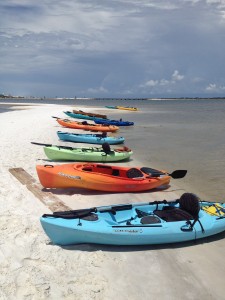 Are you interested in exploring and discovering more about the waterways and wildlife around you? If so, Panhandle Outdoors LIVE may be right up your alley. In 2012, natural resources Extension Agents took over 200 people on trips from Perdido to Apalachicola, and this yearlong series of hiking, boating, and kayaking trips is back by popular demand with 9 new locations. Local experts will provide you with insight into the “real” Florida and take you to places unique to our corner of the world. We promise you’ll go home with a new appreciation for our Florida ecosystems!
Are you interested in exploring and discovering more about the waterways and wildlife around you? If so, Panhandle Outdoors LIVE may be right up your alley. In 2012, natural resources Extension Agents took over 200 people on trips from Perdido to Apalachicola, and this yearlong series of hiking, boating, and kayaking trips is back by popular demand with 9 new locations. Local experts will provide you with insight into the “real” Florida and take you to places unique to our corner of the world. We promise you’ll go home with a new appreciation for our Florida ecosystems!
The expedition schedule is as follows:
March 15: Aucilla River Sinks (Jefferson County)
March 28: The Great Florida Wildlife Trail (Calhoun County)
April 2: Pitcher Plants & Weeks Bay (Baldwin County, Alabama)
May 8: Coastal Dune Lakes (Walton County, Florida)
June 6: Yellow River & Boiling Creek (Santa Rosa County)
August 15: Saltwater Marshes of St. Andrews Bay (Bay County)
September 24: Apalachicola National Estuarine Research Reserve (Franklin County)
October 3: Blackwater River State Forest (Santa Rosa County)
November 15: Seagrasses & Manatees of Apalachee Bay (Wakulla County)
Each day starts at 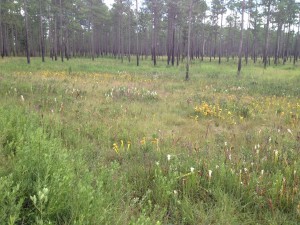 9:30 am central/10:30 am eastern and runs to 4:00 central/5:00 eastern. Please arrive at least 20 minutes early for each trip to ensure the events can start on time. Depending on location, moderate walking, hiking, swimming, and/or paddling may be involved. Lunch, park entry fees, and rentals will be provided for each participant (18 and up only) at a cost of $30.
9:30 am central/10:30 am eastern and runs to 4:00 central/5:00 eastern. Please arrive at least 20 minutes early for each trip to ensure the events can start on time. Depending on location, moderate walking, hiking, swimming, and/or paddling may be involved. Lunch, park entry fees, and rentals will be provided for each participant (18 and up only) at a cost of $30.
Click here for registration and contact information. Space is limited, so register early!
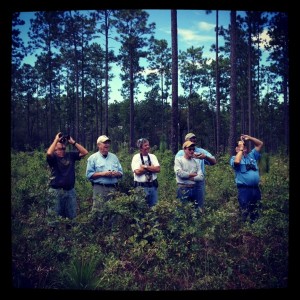
Enjoy exploring Northwest Florida during Panhandle Outdoor Live 2013
Necessary equipment and clothing will vary based on weather and location, but participants should bring sturdy shoes, drinking water, sunscreen, and a camera to each trip. Transportation to each location will be facilitated by carpooling, and some counties may be able to provide transportation.
by Judy Biss | Jan 9, 2013
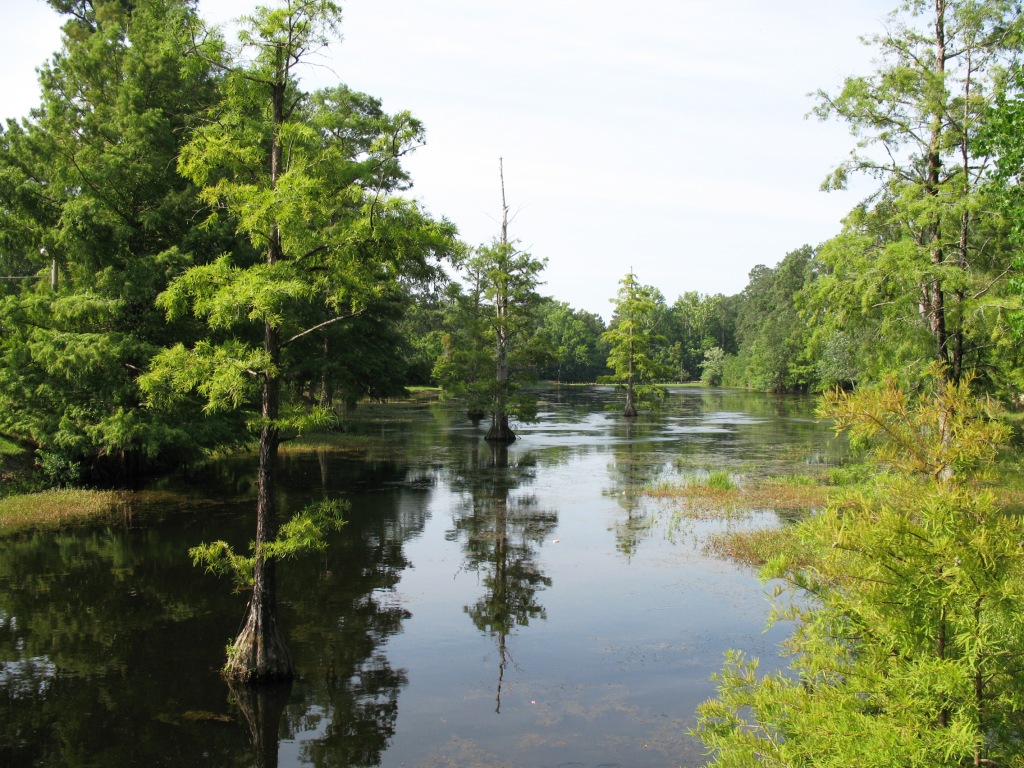
No matter our distance from a lake, wetland, river, or coastline, we all live within the boundaries of a watershed – photo by Judy Ludlow
No matter our distance from a lake, wetland, river, or coastline, we all live within the boundaries of a watershed. In fact, all land on earth is part of a watershed and all habitats exist within a watershed boundary. The size of watersheds can vary from a few square feet to millions of acres. It is important to realize our location is always within a watershed. All domestic, agricultural, horticultural, or industrial activities that occur in a specific watershed will impact surrounding water quality and quantity.
The United States Environmental Protection Agency defines a watershed as “an area of land where all of the water that is under it or drains off of it goes to a common waterway, such as a stream, lake, estuary, wetland, aquifer, or even the ocean.” Think of a watershed as a bowl or basin formed by the elevation of surrounding terrain. Gravity moves rainwater, surface water, and groundwater down the basin to its lowest point ending in a body of water.
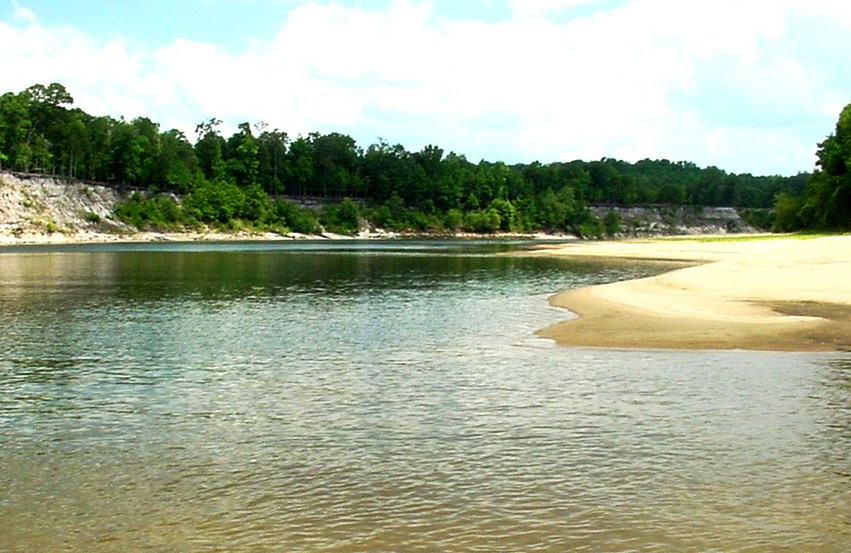
Being aware of your actions within the watershed is important to the long term water quality and quantity of your favorite panhandle Florida lake, river, or spring run – photo by Judy Ludlow
With that description in mind (water moving to the lowest point), think about the daily activities within your watershed. Watersheds contain houses, cars, businesses, natural areas, timber lands, agriculture, gardens, golf courses, shopping malls, pavement, septic systems, factories etc. So no matter where we are within our watershed, whatever falls to the ground (wash water, chemicals, fertilizers, fuels, oils, wastes, etc.) within that watershed will flow “downhill” to the water system that drains it. You may think the accidentally spilled motor oil may never reach the nearest lake, but it will impact the surface water and/or ground water as it moves downhill through the watershed. You may also think one isolated spill is insignificant. Keep in mind however; the more densely populated a watershed is, the greater the frequency and volume of impacts to surface and ground water will be.
Whether you are a business or individual, becoming aware of your watershed “address” is a novel way to view your essential connection to your water resources. Becoming aware, also, of your actions within the watershed, is important to the long term water quality and quantity of your favorite Panhandle lake, river, or spring run.
For more information about locating your watershed “address” and about watershed management please see the following resources.
Watersheds – Functions and Management
Find Your Watershed “Address”
Watersheds of Florida: Understanding a Watershed Approach to Water Management
Know Your Watershed
by Scott Jackson | Nov 14, 2012
Holiday dinners usually feature ham and turkey. You may start having left-over sandwich nightmares after eating turkey for the next six weeks! Many Florida families choose fresh seafood as a delicious and healthy addition to their traditional holiday meals.

Fish on a thick bed of ice with bellies down. Courtesy of Florida Sea Grant
This is a great time of year to purchase and enjoy seafood. There is quality fish, shrimp, and shellfish currently at your local grocery store or seafood market. Usually with the holidays, there’s more time to explore new recipes in the kitchen. Fresh ingredients are the key to any good recipe and helps ensure healthy eating. The National Oceanic and Atmospheric Administration (NOAA) FishWatch website (www.fishwatch.gov) provides consumers with information regarding seafood nutrition, safety, and sustainability.
FishWatch suggests the following when shopping for fresh fish:
- To be sure the safety of seafood is being properly preserved, only buy fish that is refrigerated or properly iced. Fish should be displayed on a thick bed of fresh ice that is not melting and preferably in a case or under some type of cover. Fish should be arranged with the bellies down so that the melting ice drains away from the fish, thus reducing the chances of spoilage.
- Fish should smell fresh and mild, not fishy, sour, or ammonia-like odors.
- A fish’s eyes should be clear and bulge a little (except for a few naturally cloudy-eyed fish types, such as walleye pike).
- Whole fish and fillets should be firm and spring back when pressed.
- Fish should have shiny flesh and bright red gills free of slime. Dull flesh could mean the fish is old. Note: Fish fillets that have been previously frozen may have lost some of their shine, but they are fine to eat.
- Fish fillets should display no darkening or drying around the edges. They should have no green or yellowish discoloration and should not appear dry or mushy in any areas.
Fresh Florida Oysters are almost as popular during the holidays as pecans and walnuts; they are just a little more difficult to crack! Oysters are a welcomed addition to any meal, as side dishes, appetizers, or snacks between larger meals. You’ll enjoy finding great ways to prepare this nutritious shellfish.
Consumption of raw seafood such as oysters is not recommended for those whose immune systems are compromised. For example, patients completing chemotherapy or folks with blood or digestive disorders are at a higher risk for contracting bacterial infections. Ask your doctor if you have a question whether you are at higher risk. Properly cooked oysters (plump, opaque, and curled edges) are healthy choices. Cooking kills bacteria associated with raw seafood. For more information on oyster consumption and recipes visit http://safeoysters.org
One recipe that complements the traditional bird is oyster dressing. With this recipe you can enjoy both turkey and seafood together. For more oyster and seafood recipes like this one, visit www.fl-seafood.com
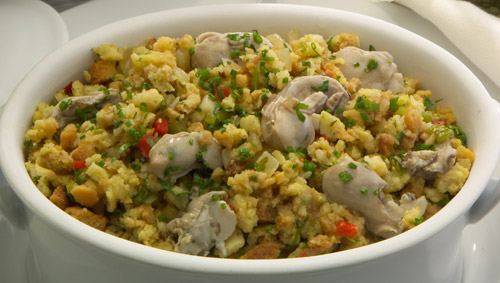
Complement a traditional holiday meal with seafood dish like oyster dressing. Courtesy of Florida Dept of Agriculture and Consumer Services (FDACS)
Ingredients:
12-ounces Florida oysters
½ c. Florida celery, chopped
½ c. Florida onion, chopped
¼ c. butter
4 c. day-old bread cubes
1 tbsp. fresh Florida parsley, chopped or 1 tsp. dried parsley
1 tsp. sage
½ tsp. salt
1/8 tsp. poultry seasoning
1/8 tsp. teaspoon pepper
Preparation:
Preheat oven to 325° F. Drain oysters; reserve liquid. Remove any remaining shell particles. Chop oysters. Cook celery and onion in butter until tender. Add oysters and oyster liquid to vegetables; cook for 10 minutes. Combine oysters, cooked vegetables, bread cubes and seasonings in a large bowl; mix thoroughly. If stuffing seems dry, moisten with additional oyster liquid or chicken broth. Bake dressing in a greased casserole dish for 30 minutes.
 Are you interested in exploring and discovering more about the waterways and wildlife around you? If so, Panhandle Outdoors LIVE may be right up your alley. In 2012, natural resources Extension Agents took over 200 people on trips from Perdido to Apalachicola, and this yearlong series of hiking, boating, and kayaking trips is back by popular demand with 9 new locations. Local experts will provide you with insight into the “real” Florida and take you to places unique to our corner of the world. We promise you’ll go home with a new appreciation for our Florida ecosystems!
Are you interested in exploring and discovering more about the waterways and wildlife around you? If so, Panhandle Outdoors LIVE may be right up your alley. In 2012, natural resources Extension Agents took over 200 people on trips from Perdido to Apalachicola, and this yearlong series of hiking, boating, and kayaking trips is back by popular demand with 9 new locations. Local experts will provide you with insight into the “real” Florida and take you to places unique to our corner of the world. We promise you’ll go home with a new appreciation for our Florida ecosystems! 9:30 am central/10:30 am eastern and runs to 4:00 central/5:00 eastern. Please arrive at least 20 minutes early for each trip to ensure the events can start on time. Depending on location, moderate walking, hiking, swimming, and/or paddling may be involved. Lunch, park entry fees, and rentals will be provided for each participant (18 and up only) at a cost of $30.
9:30 am central/10:30 am eastern and runs to 4:00 central/5:00 eastern. Please arrive at least 20 minutes early for each trip to ensure the events can start on time. Depending on location, moderate walking, hiking, swimming, and/or paddling may be involved. Lunch, park entry fees, and rentals will be provided for each participant (18 and up only) at a cost of $30.




